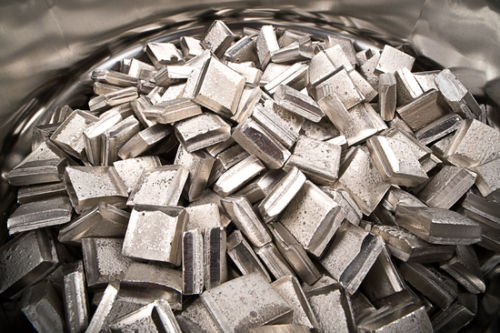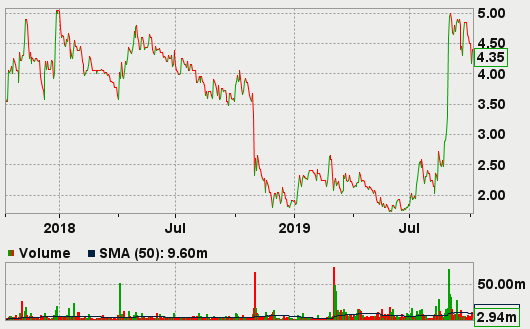Horizonte Minerals – A Very Long Term Investment Opportunity?

A resurgent nickel price has spurred the shares of Horizonte Minerals to double in value almost overnight, writes John Cornford.
Apart from iron and steel, the two most important industrial metals fuelling world growth over many years have been copper and nickel – the first mainly for electrical equipment, the second for stainless steel but increasingly for electrical applications, particularly for batteries.
But with world growth slowing, and electric vehicles (ev) receding into the future, the price of copper is down by around 20% from its early 2018 levels, and so, until 4 months ago, was nickel. But while the supply demand balance for copper is fairly robust, upsets to nickel supply have a bigger effect, so that the banning of exports from Indonesia in June has forced nickel prices back to a five-year high ($17,920 per tonne) – double those of early 2016 but still well short of the all-time 2011 high of $28,250/t.
And while longer term forecasts for the copper demand/supply balance are nevertheless encouraging, those for nickel are even more so, with the result that the spotlight has recently turned onto a junior miner with a very advanced nickel project in Brazil, close to established producers Teck, Glencore, and Vale.
As it happened, the resurgent nickel price came just two months before (and perhaps prompted) the first serious backing in August from an institutional investor (Orion Finance) for Horizonte Minerals’ steadily growing but still some way from finalised Araguaia nickel project in Brazil, spurring the shares to double almost overnight to a market cap around £69m.

Horizonte Minerals – last three years
HZM has steadily increased its exposure to nickel, having started out on AIM in 2006 as an explorer to seek gold and base metals in Brazil and Peru. In 2010, it acquired Araguaia, then at an advanced exploration stage that, following the 2008 financial crash, mining major Teck had decided to dispose of to concentrate on its other prospects. Teck thereby became a 50% shareholder.
Over time, Teck has kept its holding, although becoming proportionally less, while HZM has added further nearby resources obtained from Glencore, all the while proving up Araguiai, despite funding being hindered by nickel prices which weakened markedly, and in 2016 fell to 1/3rd 2010 levels before slowly recovering in 2018.
That, however, was probably a blessing in disguise, prompting both Teck and, later, Glencore to sell off some of their assets to Horizonte, at very cheap prices.
Teck is still a supporter and Araguiai’s promise was recognised by a build-up of some institutional shareholders, before a feasibility study in 2017-8 showed a 8% NPV (net present value) of $401m at a $14,000/t nickel price with a 20.1% post-tax IRR (internal rate of return) following a $445m capital spend.
At $18,000/t that NPV becomes $885m with a 31% IRR, and while 20% is a reasonable return, it is not particularly exciting to mine financiers, whereas 30% becomes quite attractive.
That is not all, relating as it does to only a first stage of Horizonte’s Araguaia project which also has a potential second stage. That would double output at proportionately lower cost and would add an average $88m pa of free cash flow over its 29 year mine life, to the $54m pa delivered by stage one. That’s at a $14,000 nickel price, whereas at today’s $18,000/t, the total would become $265m pa.
That’s still not all however, because in 2017 HZM made another transformational but cheap acquisition , of Vale’s near term, slightly smaller but particularly suitable for EV batteries, Vermelho nickel-cobalt project in the same Brazil region. HZM therefore now has two complementary projects with eventual scope to produce 75,000 tonnes annually of nickel, with a yearly sales value (at today’s $18,000/t price) of over $1.3bn. That would take Horizonte into the top five nickel producers world-wide.
But before getting there, the $445m phase one capex must be found (phase two is hoped can be financed by phase one’s cash flow – but I wouldn’t count on that being enough)
That’s where the Orion initial (cornerstone) project financing has kick started a process to raise the rest, which has already started with negotiations to raise around 60-65% of the total by way of a project loan, with the rest supplied via an equity raise, planned for some time in 2020. Investors will be waiting for that raise to see what share price the institutions will pay to stump up the remaining $141m or so.
The Orion package is only for $25m, to be repaid via a ‘streaming’ deal consisting of a 2.25% royalty on Araguiai’s stage one, 29 year life of mine gross revenue (up to a maximum of 425,250 tonnes of nickel sales), and HZM has made much of its financing advisor’s judgement that the package ‘is equivalent to having raised it at a 10p HZM share price’ (as if that means institutions would be happy to pay the same) and is ‘non-dilutive’
But I (and I suspect others) can’t see how they arrived at that calculation, and I would disagree that the package is ‘non-dilutive’. Much easier to understand is that, according to the 2018 updated feasibility study, at a $14,000/tonne nickel price a 2.25% lower sale price would reduce the $410m NPV by 9.7%. In other words, the sale value foregone by HZM would be equivalent to a $65m ‘cost’ to the NPV.
Looked at another way, if nickel were to be $18,000/tonne throughout the whole 29 year mine life, the revenue foregone would be the equivalent of a repaying a project loan at 23% pa interest – which is in line with most streaming finance deals whose usurious (in my opinion) terms are hardly ever made clear by those involved. (At a $14,000/t nickel price, it would be the equivalent of a 18% bank loan, with a repayment NPV of $50m to be deducted from the project NPV).
These calculations may appear esoteric to a private investor who looks at the apparently large cash flows generated once a project is up and running and thinks they mean a high share price.
But to take account of their limited lives, calculating the NPV of a mining project allowing for all the deductions that a private investor would overlook (and despite that an NPV is a far from accurate predictor of a share price – remember Sirius Minerals) is the method institutions and banks will use to decide what is a sensible price to pay for an investment, so is the one I will use to estimate what that share raise price will be. I don’t expect it to be anywhere near 10p.
That’s basically because – as I’ve explained at length in other articles – particularly for Sirius Minerals where our best ‘sell’ so far was to dump it before its 2016 1st stage funding – a ‘target’ share price base on the project’s NPV is never, ever, approached in practice, for all sorts of mathematical and financial reasons.
Quite apart from that, a simple calculation will show why I don’t believe the institutions will pay that 10p (all other things being equal of course, particularly the nickel price, and the results of the more detailed feasibility study for Araguaia due to be published by this year end).
Here are two cases, assuming an equity raise at the current price (4.7p) and one at 10p, and in both cases taking the high case NPV – ie $885m at a $18,000/t nickel price.
At 4.7p, the necessary $147m will require 3.13bn shares (added to the current 1.45bn) ie a 3.1 times expansion. On those expanded shares, the NPV, once all capex is raised and spent, will be $885m + $445m (capex) less Orion streaming repayment ($50m NPV) less bank loan repayment ($300m NPV) = $980m which, divided by 4.58 bn shares = 21.4p per share., ie a 355% premium to 4.7p.
On the same basis at a 10p share raise price, the extra shares required will be 1.47bn to give a 2.92 bn total shares in issue. The NPV will be the same $980m, to give a theoretical 3.35p NPV per share – a 235% premium to the raise price- ie a lower premium (or ‘profit’ on the raise price) than at 4.7p.
But both these calculations are on a NPV basis (which is easy to use even if unreliable) and, as I have argued and explained many times elsewhere, gives a highly exaggerated end result for share prices actually achieved which even at the height of the last mining share boom in 2011 hardly ever approached half the theoretical NPV based price, and was most often only 1/3rd. I’ve never found one since to disprove that rule. (Broker analysts keep using it because it helps ‘sell’ the share to private investors. Institutions never take notice of them.)
So my conclusion is that over the next 2 years or so, the shares won’t be valued by the institutions for a cash raise (or by the bidder who some investors hope will appear) at much higher than the present, and for Araguaia stage one will be at well below 10p. Having said that, its £54m average annual cash flow on the 4.6 bn shares in issue after a 4.7p funding would be 10p per share, so some might be tempted to apply a PER (price to earning ratio) to arrive at a much higher price than the NPV calculation suggests. But that would ignore the limited mine life, and that in the first four-five years operation all stage one cash flow will be diverted to fund stage two, quite apart from that required for Vermelho.
That’s not to say that the medium/longer term future for HZM (if those phase two expansion and Vermelho projects actually happen) doesn’t look very attractive. The project economics for each one, added to the Araguaia one, will add up to perhaps a $1.5bn NPV. But that is a long way off, and, meanwhile, the shares will react to nickel – which some observers think will relapse again for a while – and to funding issues. I wouldn’t deter anyone buying now for the very long term, but certainly wouldn’t chase.
One thing you failed to account for is the 30% take over rule when issuing more shares to raise the necessary capex.
Can you calculate your figures again please?